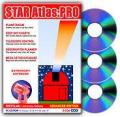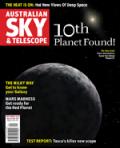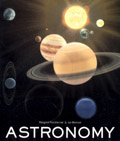ICEINSPACE
|
Moon Phase
CURRENT MOON
Waning Gibbous 70.9%
|

|
 |
IceInSpace Xmas 2005 Competition!
And the Winners Are...Congratulations to the following winners of the IceInSpace Xmas 2005 Competition!
- 1st Prize Winner - cometcatcher
- 2nd Prize Winner - Volans
- 3rd Prize Winner - Jules
Many thanks to Bintel, Eddie Trimarchi, Australian Sky & Telescope, myAstroShop and SKY Lab: Astronomy Software for their support and sponsorship of the competition.
And many thanks to the members of IceInSpace for their continuing valued support and for taking part in the competition.
 |
 |

Click to Enlarge
Mike (iceman) from IceInSpace (left) and Michael from Bintel (right)
 |
After our 1st Birthday Competition in September, the most common feedback I received was how much the participants enjoyed doing the research for the questions - how much they learnt in order to answer the questions. So I've organised another competition, the IceInSpace Xmas 2005 Competition.
To celebrate Xmas 2005, we're having a competition open to IceInSpace members. It's a way for me to give something back to the IceInSpace community, a way for the sponsors to integrate more with the amateur astronomy community, and it's a great talking point for our members and will hopefully see more people sign up and see the community grow.
In order to encourage more participation for this competition, the questions will be multiple choice, and to be in the draw to win the prizes, you only need to get 1 answer correct!!
The competition is kindly sponsored by Bintel, SKY:Lab Astronomy Software, Eddie Trimarchi, Australian Sky & Telescope and My Astro Shop. The competition will be in the form of 30 multiple choice quiz style questions about astronomy, and you will have three weeks to get your entries in. We welcome all new members to be part of our Xmas 2005 Celebrations!
The prizes, thanks to our generous supporters are:
1st place
 |
 |  |  |

Click to Enlarge
13mm Nagler Type 6
 |
 | 
Click to Enlarge
MilkyWay in H-a
 |
2nd place
 |
 |  |  |

Click to Enlarge
STAR Atlas:PRO™ - Advanced Edition - Level III
 |
 | 
Click to Enlarge
Australian Sky & Telescope
 |
3rd place
 |
 |  |  |  |  |

Click to Enlarge
Astronomy
 |
 | 
Click to Enlarge
Exploring the Moon
 |
 | 
Click to Enlarge
The Night Sky
 |
All place getters will also receive an IceInSpace pen and some IceInSpace stickers.
How To EnterTo enter the competition, follow these easy steps:
- You first have to be sign up to be a member of the IceInSpace Forums. To do this, simply register with the forums and don't forget to use a valid email address as you will need it to activate your account. It's free to become a member and will only take you 30 seconds!
- You will see a link to the the Quiz Entry Form below when the competition is launched. At that time, do your research, answer as many questions as you can, and then you will submit your answers online. You can only submit your answers once, so check your answers carefully!
- Submit your entry before the close date of 5pm AEDST on the 15th of December 2005.
Quiz QuestionsThe competition has now closed.
You can use the link below to see the answers you submitted, but if you did not enter you cannot submit an entry.
IceInSpace Xmas Competition Quiz Entry Form
Quiz AnswersBelow are the answers to the IceInSpace Xmas 2005 Quiz.
- What is the focal ratio of a telescope with an object diameter of 300mm and a focal length of 1500mm?
Answer: f/5. (Focal Ratio = Focal Length / Objective Diameter)
- What magnification are you using, if observing with a 6mm eyepiece in a telescope with a focal length of 1500mm?
Answer: 250x. (Magnification = Telescope Focal Length / Eyepiece Focal Length)
- What is the rotational period of Mars?
Answer: 24.62 hours. (explain)
- What is a sunspot?
Answer: A cooler region of the Suns photosphere. (explain)
- Which planet in our solar system is the least dense?
Answer: Saturn. (explain)
- The distance between the Earth and Sun is called a(n)?
Answer: Astronomical Unit. (explain)
- What constellation did the Hindus call Zizumara?
Answer: Delphinus. (explain)
- A solid body from space that lands on earth is called a?
Answer: Meteorite. (explain)
- What is the closest star to the Sun?
Answer: Proxima Centauri. (explain)
- How many constellations border the southern constellation Norma?
Answer: 5. They are Ara, Scorpius, Lupus, Circinus and Triangulum Australe.
- What is the Danjon Scale used to measure?
Answer: Darkness of a Lunar eclipse. (explain)
- Saturn's rings are?
Answer: all of the above. That is, they are composed of ice particles, in the plane of the planet's equator and within the planet's Roche limit.
- How much brighter is a magnitude 0 star compared to a magnitude 1 star?
Answer: 2.5119x brighter. (explain)
- From 1978 to 1999, which planet was farthest from the Sun?
Answer: Neptune. Because of Pluto's highly eccentric orbit, it can be inside Neptune's orbit. (explain)
- How often do the rings of Saturn appear edge-on as viewed from Earth?
Answer: 13.75 and 15.75 years alternately. (explain)
- What does the unit 'parsec' measure?
Answer: Distance. (explain)
- What is the apparent path of the sun called?
Answer: Ecliptic. (explain)
- One light year is how many Astronomical Units?
Answer: 63,000. (explain)
- How far have spacecraft from Earth travelled into space?
Answer: Somewhat less than one Light-day. (explain)
- What is a total solar eclipse?
Answer: When the moon moves between the earth and the sun. (explain)
- Who first proposed that the sun was at the center of our solar system?
Answer: Nicolaus Copernicus. (explain)
- What year boasted the first woman in space?
Answer: 1963. (explain)
- What is the term for the condition when three celestial bodies are arranged in a straight line?
Answer: Syzygy. An occulation is an example of a syzygy. (explain)
- How long does it take light from the Sun to reach Earth?
Answer: 8 minutes. (explain)
- The apparent backwards motion of planets is called?
Answer: retrograde motion. (explain)
- The point closest to the Earth for a body orbitting the Earth?
Answer: Perigee. (explain)
- What is the point in the sky directly overhead?
Answer: Zenith. (explain)
- What is an angular unit of measure (60 per degree)?
Answer: Minute of Arc. (explain)
- What is the name of the orbital point when a planet is closest to the sun?
Answer: perihelion. (explain)
- Galileo's observations of the gibbous phase of Venus proved?
Answer: that Venus orbited the sun. It is not correct to assume that all the planets orbit the Sun. (explain). "Galileo's observation of the phases of Venus proved that Venus orbited the Sun and lent support to (but did not prove) the heliocentric model."
Competition RulesPlease read the rules carefully, and be sure to ask any questions on the forum if anything is unclear. A thread discussing the competition is found here in the General Chat section.
- The competition is open to all IceInSpace Forum registered members, including the moderators. The moderators are volunteers and have had no involvement in organising this competition, so they are eligible to enter. The administrators (mojo and myself) are not eligible to enter.
- There is no minimum length of membership to be eligible to enter; anyone who is a member before the closing date can participate.
- The competition will be launched on Friday the 25th November 2005 at 9am AEDST and will run for 3 weeks. The competition will close at 5pm AEDST on Thursday the 15th of December 2005.
- All entries must be submitted using the online entry form before the closing date. Entries received after the closing date will not be eligible.
- Only 1 entry per member is accepted. You can only submit your answers once via the online quiz entry form.
- The questions are multiple choice, and there is only 1 correct answer per question.
- To be entered into the draw to win the prizes, you only have to get 1 question correct. However the more correct answers you get, the more times you will entered into the draw. The following scale will determine how many times you will be entered into the draw:
- Between 1 and 9 correct answers: 1 entry into the draw
- Between 10 and 19 correct answers: 2 entries into the draw
- Between 20 and 29 correct answers: 3 entries into the draw
- All 30 answers correct: 4 entries into the draw
- On (or around) the 20th of December 2005, all entries will be placed into a hat and the first, second and third place getters will be drawn in that order out of the barrel. The actual date of the draw will be announced as it gets closer.
- Prizes will be posted out to the winners in the week following the draw, after all winners have been contacted and acknowledged their prize.
- The Australian Sky & Telescope subscription prize is only available to Australian and New Zealand members of IceInSpace.
- The winners will be contacted via email or forum PM and may have their names displayed on this site. Make sure your profile is setup to receive PM's and ensure your email address is valid so that you can be contacted!
- All winners must acknowledge their prize within 1 week of the draw. In the event that the winner cannot be contacted, the runners up will receive the next available prize and a new 3rd place winner will be drawn.
- The prizes cannot be converted to cash.
- The judges decision is final and no correspondance will be entered into.
|
 |
|